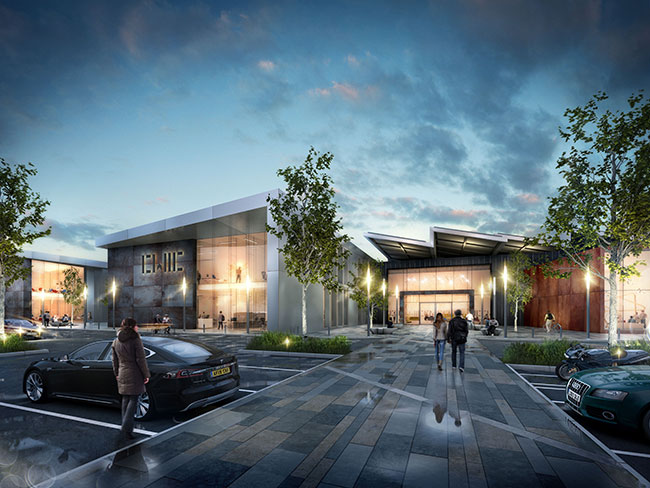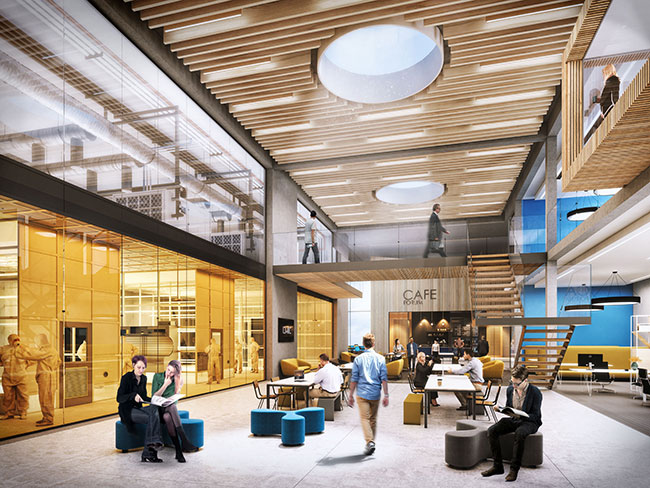High-Tech Innovation Campus to be ‘Shipbuilding Industry of 21st Century’
Published: 26 April 2019
University to create Scotland’s ‘Silicon Valley on the Clyde’
The University of Glasgow is taking forward ambitious plans for a major investment in a new Clyde Waterfront Innovation Campus on the south bank of the river in Govan– in a move the Principal Professor Sir Anton Muscatelli has said can make the city synonymous with innovation in the 21st century, in the same way that it was identified with shipbuilding and heavy industry in the 20th century.
The Clyde Waterfront Innovation Campus (CWIC) will act as a centre of excellence for a range of new technologies, co-locating industry and world-class research, and will see hundreds of high-end jobs located in Govan in the first stage. The main pillars of the first stage of the CWIC programme will be an enhanced James Watt Nanofabrication Centre (JWNC), and a Precision Medicine Living Laboratory, allowing a focus on areas and industries in which Glasgow and Scotland can truly lead the world in the decades to come.
The JWNC will focus on industries like nanofabrication for quantum technology and photonics, enabling the co-location of high-quality academic and translational assets with cutting-edge industrial R&D teams supported by state-of-the-art facilities. Even at an early stage, the plans are already supported by 12 major industry partners,and will see the re-location of Europe’s leading clean room facility from the West End to Govan.
The Precision Medicine Living Laboratory will strengthen Glasgow and Scotland’s existing position as the world-leader in Precision Medicine, by establishing new innovation pathways in a real-world clinical setting and a dedicated Health Innovation Hub that offers grow-on space and enabling "soft" infrastructures. The new Living Laboratory will flow into the existing Clinical Innovation Zone at the Queen Elizabeth University Hospital, and will be a key aspect of meeting Glasgow’s aspiration to be the ‘Silicon Valley of Precision Medicine’, an opportunity identified by President of the US National Academy of Sciences, Dr Victor Dzau.
With financial commitments of £28m from the University, and £27.5m from the Glasgow City Region City Deal already in place and with significant commitments to co-location and job-creation from leading industry partners, plans for the new campus are already well underway.
As well as providing inclusive economic growth for the city and Scotland, the new campus will provide a major boost to the local area, bringing in high-quality jobs and contributing to regeneration, while also acting as a conduit to the University for the community in Govan, with plans to establish “Invention Rooms” for use by local school pupils and young people – shared, interactive spaces to allow for collaboration between the University, the local community and industrial partners, designed to inspire a cultural of innovation and entrepreneurship amongst local residents.
The Principal, Professor Sir Anton Muscatelli, said: “The University of Glasgow’s plans for investment in Govan are an incredibly exciting new chapter for the University and the City – and can be as transformational for Govan and the Clyde Waterfront as our move to the West End from the City Centre was in 1870.
“As Glasgow’s largest university, we are determined to play a full and active part in the public life of our City and our new campus on the south bank of the Clyde will see even more of Glasgow’s communities benefit from our activity, while creating a genuine cluster of excellence in several of the leading industries of the coming decades.
“We know that the University only thrives when the City thrives – and that the City only meets its full potential when the University works closely with partners in industry and the public sector, translating our world-leading research into jobs and inclusive economic growth, and ensuring the benefits are felt by people across Glasgow.
“Shipbuilding and heavy industry in Govan and on the Clyde Waterfront were the pillars of Glasgow’s industrial excellence in the 19th and 20th centuries. I have no doubt that the innovation agenda and industries like quantum technology, nanofabrication and Precision Medicine can be to the 21st century Glasgow economy, what shipbuilding was in the past.
“As a City, we can’t afford to look backwards to past glories – we have to reimagine Glasgow’s entrepreneurial legacy for the 21st Century. And the establishment of the Clyde Waterfront Innovation Campus could create Scotland’s Silicon Valley on the Clyde, and be a key step in ensuring our City retakes its place at the forefront of international innovation and industrial excellence.”
Councillor Susan Aitken, Leader of Glasgow City Council and Chair of the Glasgow City Region City Deal Cabinet, said: “This news is a welcome addition to all the investment that is taking place as the council and our partners work together to deliver the Glasgow Riverside Innovation District, stretching from the University of Glasgow to the Queen Elizabeth University Hospital.
“The work being done to regenerate Govan, Water Row, the banks of the Clyde in this part of Glasgow and the forthcoming Partick-Govan Bridge is key to attracting and developing world-class innovation in this part of the city.”
Dr Sara Diegoli, Strategic Project Manager at the College of Science and Engineering and the lead for the quantum aspect of the CWIC project said: “Glasgow is already a world-leader in areas likes quantum technology, photonics and nanofabrication – and the Clyde Waterfront Innovation Campus will bring together a cluster of excellence from both industry and academia which will be truly unparalleled elsewhere.
“Moving existing University activities to the new innovation campus in Govan to allow more effective co-location with industry, is a major statement of intent that we want to ensure Glasgow is the best place to do business in this field – and the level of engagement even at this early stage from partners in industry, gives me great confidence that CWIC will ensure Glasgow’s place as a world-leader in enabling technologies for decades to come.
“The new campus will be the ideal platform for skills development, outreach, collaborative research and development, entrepreneurship and innovation – all while providing a real boost to the local community.”
Vice-Principal and Head of the College of Medical, Veterinary and Life Sciences, Professor Dame Anna Dominiczak, Scotland’s leading expert in Precision Medicine, said: “Scotland has the real potential to lead the world in Precision Medicine – a field which could save billions for our NHS, contribute massively to economic growth and job-creation and lead to major improvements in public health.
“The Living Laboratory proposal in particular is deeply exciting, offering a game-changing opportunity to strengthen Glasgow’s Precision Medicine eco-system, embed R&D activities at the Queen Elizabeth University Hospital and further strengthen the relationships between academia, industry and the NHS – Scotland’s unique ‘triple-helix’ approach to Precision Medicine, which is our major competitive advantage in what is a multi-billion pound industry.
“This is a project of true local, national and international importance – contributing to the regeneration of Govan, cementing Scotland’s place as the world-leader in Precision Medicine and promising a genuine revolution in healthcare right across the world. And I am delighted to see Precision Medicine placed front and centre of the University’s priorities by being based at our new Clyde Waterfront Innovation Campus.”
First published: 26 April 2019

